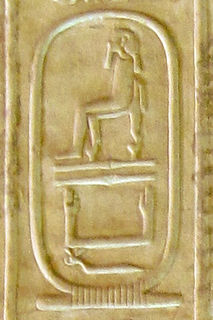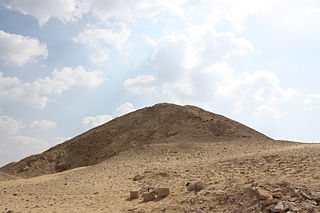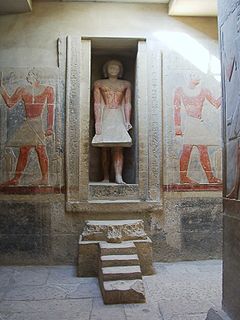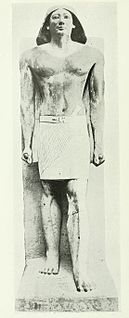
Unas or Wenis, also spelled Unis, was a pharaoh, the ninth and last ruler of the Fifth Dynasty of Egypt during the Old Kingdom. Unas reigned for 15 to 30 years in the mid-24th century BC, succeeding Djedkare Isesi, who might have been his father.

Memphis or Menefer was the ancient capital of Inebu-hedj, the first nome of Lower Egypt that was known as mḥw ("north"). Its ruins are located near the modern town of Mit Rahina, 20 km (12 mi) south of Giza in Greater Cairo, Egypt.

Saqqara, also spelled Sakkara or Saccara in English, is a vast, ancient burial ground in Egypt, serving as the necropolis for the ancient Egyptian capital, Memphis. Saqqara contains numerous pyramids, including the world-famous Step pyramid of Djoser, sometimes referred to as the Step Tomb, and a number of mastaba tombs. Located some 30 km (19 mi) south of modern-day Cairo, Saqqara covers an area of around 7 by 1.5 km.

Teti, less commonly known as Othoes, sometimes also Tata, Atat, or Athath in outdated sources, was the first king of the Sixth Dynasty of Egypt. He is buried at Saqqara. The exact length of his reign has been destroyed on the Turin King List but is believed to have been about 12 years.

Shepseskaf was the sixth and last pharaoh of the Fourth Dynasty of Egypt during the Old Kingdom. He reigned six to eight years starting circa 2510 BC. The only activities firmly datable to his reign are the completion of the temple complex of the Pyramid of Menkaure and the construction of its own mastaba tomb at South Saqqara, the Mastabat al-Fir’aun, "stone bench of the pharaoh".

Menkauhor Kaiu was an Ancient Egyptian pharaoh of the Old Kingdom period. He was the seventh ruler of the Fifth Dynasty at the end of the 25th century BC or early in the 24th century BC.

The Pyramid Texts are the oldest ancient Egyptian funerary texts, dating to the late Old Kingdom. They are the earliest known corpus of ancient Egyptian religious texts. Written in Old Egyptian, the pyramid texts were carved onto the subterranean walls and sarcophagi of pyramids at Saqqara from the end of the Fifth Dynasty, and throughout the Sixth Dynasty of the Old Kingdom, and into the Eighth Dynasty of the First Intermediate Period.
Prince Khaemweset was the fourth son of Ramesses II, who was born c. 1303 BCE; died July or August 1213 BCE; reigned 1279–1213 BCE, and the second son by his queen Isetnofret. His contributions to Egyptian society were remembered for centuries after his death. Khaemweset has been described as "the first Egyptologist" due to his efforts in identifying and restoring historic buildings, tombs and temples.

The Pyramid of Teti is a smooth-sided pyramid situated in the pyramid field at Saqqara in Egypt. It is the second known pyramid containing pyramid texts. Excavations have revealed a satellite pyramid, two pyramids of queens accompanied by cult structures, and a funerary temple. The pyramid was opened by Gaston Maspero in 1882 and the complex explored during several campaigns ranging from 1907 to 1965. It was originally called Teti's Places Are Enduring. The preservation above ground is very poor, and it now resembles a small hill. Below ground the chambers and corridors are very well preserved.

Mereruka served during the Sixth Dynasty of Egypt as one of Egypt's most powerful officials at a time when the influence of local state noblemen was increasing in wealth and power. Mereruka held numerous titles along with that of Vizier, which made him the most powerful person in Egypt after the king himself. Some of the other state titles which Mereruka held included 'Inspector of the priests attached to the pyramid of Teti', 'Governor of the palace', 'Chief lector-priest', 'Overseer of the royal record scribes' and 'Director of all the works of the king'.
Thamphthis is the hellenized name of an ancient Egyptian ruler (pharaoh) of the 4th Dynasty in the Old Kingdom, who may have ruled around 2500 BC under the name Djedefptah for between two and nine years. His original Egyptian name is lost, but it may have been Djedefptah or Ptahdjedef according to William C. Hayes. Thamphthis is one of the shadowy rulers of the Old Kingdom, since he is completely unattested in contemporary sources. For this reason, his historical figure is discussed intensely by historians and Egyptologists.

Isesi-ankh was an ancient Egyptian high official during the second half of the Fifth Dynasty, in the late 25th to mid 24th century BC. His name means "Isesi lives". He may have been a son of pharaoh Djedkare Isesi and queen Meresankh IV, although this is debated. Isesi-ankh probably lived during the reign of Djedkare Isesi and that of his successor Unas. He was buried in a mastaba tomb in north Saqqara, now ruined.

The High Priest of Ptah was sometimes referred to as "the Greatest of the Directors of Craftsmanship" (wr-ḫrp-ḥmwt). This title refers to Ptah as the patron god of the craftsmen.
Sabu also called Tjety was the High Priest of Ptah in the Sixth Dynasty of Ancient Egypt, around 2300 BC. Sabu is mainly known from the remains of his mastaba in Saqqara (E.3). The inscriptions on the fragment of a false door were copied in the 19th century and present part of a biography. The fragments are today in the Egyptian Museum in Cairo. Sabu bears several titles including: Greatest of the Directors of the Craftsmen in the two houses, chief lector priest, sole friend and count.
Sabu called Kem was High Priest of Ptah, probably during the reign of Pepi I. His precise titles include greatest of the directors of craftsmen belonging to the day of the festival of the Sun, priest of Sokar in the two houses and priest of Ptah.

Ranefer or Ranofer was a High Priest of Ptah, who lived at the beginning of the Fifth Dynasty of Ancient Egypt. His name means "Ra is beautiful". His main title was "greatest of the directors of craftsmen belonging to the day of festival". This is a variation of the title normally assigned to the high priest of Ptah.

The West Field is located on the Giza Plateau, to the west of the Great Pyramid of Giza. It is divided up into smaller areas like the cemeteries known as the Abu Bakr Excavations, as well as several cemeteries whose toponyms are based on the mastaba numbers such as Cemetery G 1000 and Cemetery G 1100. The West Field contains Cemetery G1000 – Cemetery G1600, and Cemetery G 1900. Further cemeteries in this field are: Cemeteries G 2000, G 2200, G 2500, G 3000, G 4000, and G 6000. Three other cemeteries are named after their excavators: Junker Cemetery West, Junker Cemetery East and Steindorff Cemetery.
Mehu was an Ancient Egyptian vizier who lived in the Sixth Dynasty, around 2300 BC. The office of the vizier was the most important one at the royal court. Mehu is mainly known from his monumental mastaba at Saqqara, not far away from the Pyramid of Unas.

Ptahshepses was an ancient Egyptian official at the end of the Fourth and the beginning of the Fifth Dynasty. His main title was that of a great one of the leaders of craftsmen, that in later periods is the main designation of the High Priest of Ptah.
Akhethetep was an ancient Egyptian official mainly known from his mastaba found at Saqqara. Not much is known about Akhethetep. On the reliefs of his mastaba he bears several titles, including overseer of the great house. This was an administrative title of rather unclear function. He had also several religious titles, including priest of Maat and priest of Hathor, lady of Dendera. He had also priestly functions at the funerary cult of different kings and was Priest of Nefer-Djedkare (this is the name of the pyramid of king Djedkare and priest at Nefersut-Unas.













